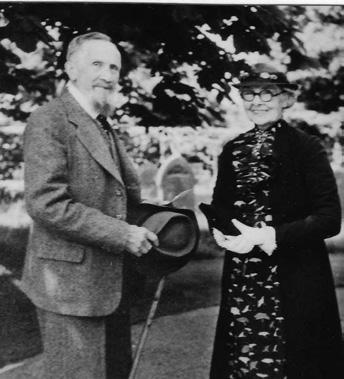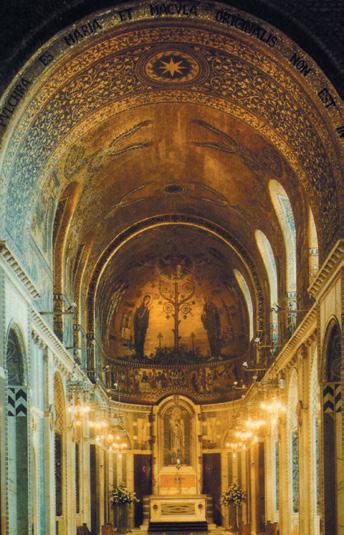
5 minute read
Discovering Treasures: The Victory Altar Frontal by Richard Hawker
Red for Victory
Richard Hawker, Head Sacristan
The casual subscriber to the Cathedral Chronicle in June 1946 would have read the following entry:
‘It is hoped that on Whitsunday we shall see for the first time the new red “Victory” frontal, the cost of which has almost been raised by the Altar Society during the past year.’ It is therefore propitious that 76 years later, almost to the day, that the high altar was adorned on Whitsunday (that is, Pentecost) with the self-same Victory frontal, obviously commissioned to celebrate victory in Europe during the Second World War.
Some may find the colouring somewhat peculiar. There is a tendency in the eyes of the English to think that the only shade of red acceptable is that of the side of a London bus, and many of our red vestments and hangings are in this very ‘primary’ red. But there is a spectrum of colour, rather than one shade having to fit all situations. Our Victory frontal is of a much more ‘tertiary’ colour, often referred to as Sarum Red. It is a very successful attempt at harmonizing with the marble in the sanctuary, rather than trying to overpower it. It is also a singularly appropriate colour when one considers our red brick exterior.
Enough theorizing on the subject of colour however; let us turn our attention to the design of the frontal itself. Consistent with many of our altar frontals, the Victory frontal necessarily incorporates a large, simple, strong design, so as to be asily visible and striking from any distance, but especially from the back of the Cathedral. The frontal draws our eyes to the very thing it covers: the altar of sacrifice, the primary focus of our worship of God. The contrasting blue, yellow, and gold appliqué and cord-work help to emphasise the redness of the frontal. These more muted colours allow the red to shine through, without being overpowered, but supported by the ornamentation. This decoration shows highly stylised leaves and bindings, also worked with stitching in the same colours, which helps to provide some depth and texture to what would otherwise be a very flat design. At the centre is a monogram of the Greek letters Chi and Rho: an ancient symbol for Christ.
We see a reasonable amount of this frontal through the year: it is generally used for Pentecost, the Holy Apostles, and the English Martyrs.
The Victory Frontal in use at the Cardinal’s Pentecost Mass in Thanksgiving for the Platinum Jubilee

Storms of Controversy – The Early Mosaics
Patrick Rogers
The period 1933-35 witnessed the greatest uproar in the history of the Cathedral. It was all about the new mosaics. The man who instigated and organised the protest was an author and expert on Italy, Edward Hutton. After his death in 1969 his papers were given to the library of the British Institute of Florence, which subsequently granted access to the Cathedral. The papers provide new and revealing insights into what really went on during those troubled years.
When Francis Bourne became Archbishop of Westminster in 1903, the Cathedral was largely devoid of mosaics. After visiting Sicily in 1905, Bourne decided that what he wanted was something resembling the 12th century Norman-Byzantine mosaics of Palermo and Monreale. He continued to be disappointed with the mosaics going up in the Cathedral and believed that this was because they had been designed by nonCatholic artists. But in 1923 he had his portrait painted by a Catholic artist, Gilbert Pownall, and was convinced that at last he had found the man to bring Monreale to Westminster. Pownall was sent to Italy to study the mosaics there and then began his designs, a school of mosaics being established in the Cathedral tower in 1930 to execute them.

Gilbert Pownall and his wife. Gilbert Pownall’s mosaics in the Lady Chapel. Installed 1930-35.
The Flight into Egypt scene in the Lady Chapel.


Pownall’s first mosaics were unopposed, the design for a confessional recess being viewed by the Times only as a little too pictorial. Similarly, the mosaic for St Peter’s Crypt was, and is, generally considered to be Pownall’s best. But before this was completed by the mosaicists, storm clouds were gathering with the unveiling, in February 1932, of the Lady Chapel apse mosaic, described in the Catholic Times as ‘sprawling meanly and anaemically over the vault’. Then at the end of 1933 the great blue Cathedral sanctuary arch mosaic was unveiled. On 7 December the Daily Telegraph published a letter from Edward Hutton in response, introducing him as a critic of Italian and Byzantine art. The letter described the Lady Chapel mosaics as ‘meaningless, weak and incoherent’ and that on the sanctuary arch as ‘seeming to involve the whole great church in little less than ruin’.
But it was not Hutton’s letter which caused the furore. It was Cardinal Bourne’s furious response in the Cathedral Chronicle of January 1934, in which Pownall was defended and Hutton’s credentials as an art critic challenged. The confrontation was immediately taken up in the national press and Hutton had achieved the publicity he needed, writing again in the Telegraph in January to point out that Our Lady in the Lady Chapel had been portrayed as the patron saint of London, thus depriving St Paul of that title. Nevertheless Bourne continued to support Pownall and in July a model for the mosaic decoration of the Cathedral apse was put on display for comment. Again Hutton wrote to the Daily Telegraph, this time describing the model as ‘very feeble, ugly and confused in design, without dignity or beauty’. Work on the apse mosaic began in the autumn.
Cardinal Bourne died in January 1935 and Cardinal Hinsley succeeded him. This time Hutton tried a different tack. His papers in Florence reveal that in January 1933 the Burlington Magazine had suggested that he draw up a protest petition signed by influential people. They also show that the publicity he had attracted by 1933-34 had resulted in wide support, including that from two Chaplains at the Cathedral, though one was mainly concerned about the discomfort of the Canons’










